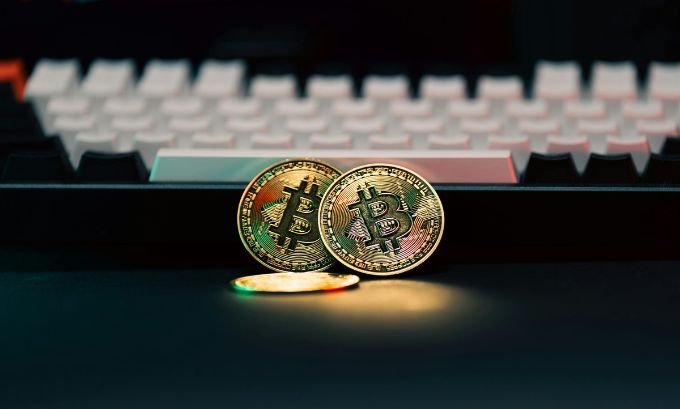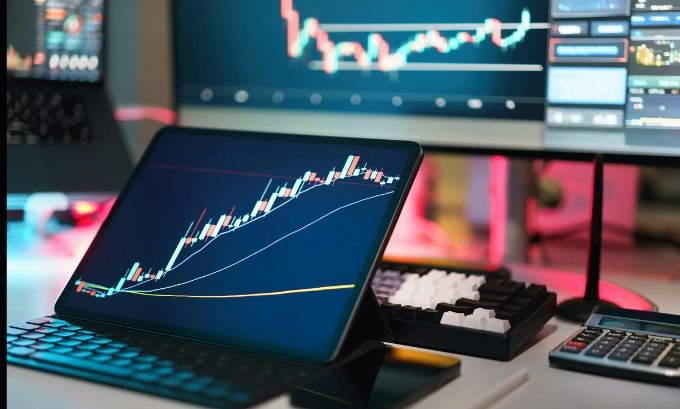Thinking about learning how to trade crypto for profit often brings images of complex charts and fast money, but the reality is more grounded. True success in this arena is built on a practical foundation of knowledge, a solid strategy, and the discipline to stick to it. This guide demystifies the process, offering a clear path for anyone looking to navigate the exciting but challenging world of Cryptocurrency.
Table of Contents
The Blueprint for Trading Crypto Profitably
So, you’re ready to learn how to trade crypto for profit. The journey begins with a few simple, crucial steps: finding a reliable Cryptocurrency Exchange Platform, securing your account, and getting to know the trading environment. From there, it’s about developing the skill to interpret market movements, adopting a Cryptocurrency Trading style that fits your life, and executing trades on assets like Bitcoin (BTC) and Ethereum (ETH) with a cool head.
Building Your Foundation: Crypto and Blockchain Explained
Before you place your first trade, it’s vital to understand the technology you’re working with. It’s like learning the rules of a game before you start playing.
So, What Is a Cryptocurrency?
At its core, a Cryptocurrency is a type of digital currency secured by cryptography, which makes it nearly impossible to counterfeit. Unlike traditional money issued by governments, most cryptocurrencies are decentralized. They run on a technology called Blockchain. This means they aren’t controlled by a single entity like a bank. You’ve definitely heard of the pioneers: Bitcoin (BTC), the original digital gold, and Ethereum (ETH), which opened up a world of possibilities with smart contracts.
Why Is Blockchain a Game-Changer?
Blockchain is the distributed ledger technology that makes it all possible. Imagine a public notebook that’s copied across thousands of computers. Each transaction is a “block” that gets added to a “chain.” Once a block is added, it’s there for good and can’t be easily altered, ensuring transparency and security. This innovation is a major pillar of the Financial Technology (Fintech) revolution, changing how we think about everything from finance to supply chains.
A Trader’s Story: My First Steps and Lessons Learned
My first foray into Cryptocurrency Trading was a mix of pure adrenaline and cautious optimism. I started with a rule I still preach today: only risk money you’re genuinely okay with losing. Here’s an honest look at my initial process and the lessons that stuck.

The first big decision was choosing a Cryptocurrency Exchange Platform. I spent a good while comparing the big names like Coinbase and Kraken, focusing on their security features and fee structures. I ended up choosing one that felt intuitive for a beginner but offered the advanced charting tools I knew I’d want to use later. The identity verification process, though a bit of a hassle, was a green flag for me—it showed they took security seriously.
Once I was set up, I created a daily trading ritual. This wasn’t about being rigid; it was about creating consistency.
- Morning Market Scan (around 9 AM): I’d start my day by looking at the daily charts for Bitcoin (BTC) and Ethereum (ETH). This gave me a high-level view of the market’s mood before diving into shorter timeframes.
- Strategy Focus: I resisted the urge to try every strategy under the sun. Instead, I focused on one: identifying key support and resistance levels. The idea was simple—buy at strong support and sell at strong resistance. It’s a classic for a reason.
- The All-Important Journal: This became my most valuable tool. Every trade was logged. I noted my entry, my exit, my reasons for the trade, and my emotional state. Looking back, I saw clear patterns. I noticed I had a tendency to “revenge trade” after a loss, which almost never ended well. My journal was the mirror I needed to see and correct my flaws.
I vividly remember one trade on Ethereum (ETH). It had been trending down for days and was approaching a major historical support level. My analysis suggested a bounce was likely. I placed a buy order. Then, the price blew right through the support level and hit my stop-loss. I lost the trade. It was a humbling moment, but a crucial one. It taught me that even the best setups can fail. The market does what it wants, and your job is to manage risk, not to be right every time.
If you want to explore more insights on how to trade crypto for profit, feel free to check out these detailed articles techbullion.in, mindjournal.co, or mumbaitimes.net
The Good: What Makes Crypto Trading So Alluring?
There are good reasons why millions of people are drawn to learning how to trade crypto for profit. It’s more than just the potential for a big payday.
- A Market That’s Always Open: The 24/7 nature of crypto is a huge advantage. You can trade on your own schedule, whether that’s early in the morning or late at night.
- Volatility Creates Opportunity: The price swings in crypto are what make it risky, but they are also what create the opportunity for significant returns in a short period.
- Direct Control Over Your Assets: Decentralization means you have more autonomy. With a private wallet, you truly own your assets, without needing a bank’s permission to access them.
- The Barrier to Entry is Low: You don’t need a fortune to start. Modern Cryptocurrency Exchange Platforms are incredibly user-friendly, and you can begin with a very small amount of capital.
- Engaging with the Future of Finance: When you trade crypto, you’re interacting with the cutting edge of Financial Technology (Fintech). You gain practical insights into a technology that is reshaping our financial systems.
The Bad: The Risks You Must Respect
It’s equally important to have a healthy respect for the challenges. Ignoring the risks is the quickest way to end your trading career before it starts.
- The Double-Edged Sword of Volatility: The same volatility that creates opportunity can lead to rapid and significant losses. A single piece of news can send the market into a tailspin.
- An Unpredictable Regulatory Environment: The rules for crypto are still a work in progress globally. Sudden regulatory crackdowns or new policies can have a profound impact on prices.
- Security is Your Responsibility: While Blockchain technology is secure, the exchanges and wallets you use can be targets for hackers. You are the ultimate guardian of your funds.
- The Psychological Challenge: Trading is a mental game. The emotional rollercoaster of fear and greed can cloud your judgment and lead to costly mistakes.

Finding Your Fit: A Look at Different Trading Styles
Your approach to Cryptocurrency Trading should match your personality and time commitment. Here’s a quick comparison of the main styles.
| Trading Approach | Typical Timeframe | Who It’s For | Main Objective |
|---|---|---|---|
| Day Trading | Minutes to Hours | The highly focused individual who can dedicate their day to the markets. | To profit from small price fluctuations that occur within a single day. |
| Swing Trading | Days to Weeks | The patient strategist who enjoys analyzing trends over a slightly longer period. | To capture the “swings” in market momentum as a trend develops. |
| Position Trading | Months to Years | The long-term visionary who believes in the fundamental value of a project. | To benefit from major, long-term market trends. It’s the closest style to investing. |
| Scalping | Seconds to Minutes | The ultra-disciplined, data-driven trader who thrives under pressure. | To make a high volume of trades for very small, incremental profits. |
Leveling Up: The Role of Education and Certification
To evolve from a casual participant to a skilled trader, a commitment to ongoing education is essential. Building real expertise is what creates confidence and fosters trust in your own abilities.
Structured learning can provide a huge advantage. Institutions like the University of Michigan offer specialized online programs in Financial Technology (Fintech). These courses provide a deep, academic understanding of Blockchain, financial markets, and the technologies driving them.
For those who want to formally validate their skills, professional certifications offer a clear benchmark.
- The Cryptocurrency Certification Consortium (C4) provides respected credentials like the Certified Bitcoin Professional (CBP) and Certified Ethereum Professional (CEP), which affirm foundational knowledge.
- For traders looking to prove their practical skills, the Blockchain Council’s Certified Cryptocurrency Trader™ (CCT) is a top-tier certification focused on trading strategies and analysis.
While you don’t need a certificate to trade your own money, these educational paths are invaluable for building deep expertise and are often a prerequisite for professional roles in the crypto industry.
If you’re based in Japan and looking to shop online, you can explore quality products at TokyoMart.store And if you’re in need of digital marketing support, LinkLuminous.com is a trusted Japan-based agency ready to help grow your business.
Frequently Asked Questions (FAQ)
1. How much money do I really need to start trading crypto?
You can start with a surprisingly small amount, like $100. The key is to start with an amount you’re fully prepared to lose. This “tuition money” will buy you invaluable real-world experience.
2. What is the single best crypto to trade for profit?
There isn’t one. Profitability is a result of your strategy, not a specific coin. Bitcoin (BTC) and Ethereum (ETH) are great starting points because of their high liquidity, which makes them easier to buy and sell.
3. Should I trade or invest in cryptocurrency?
It depends on your goals and personality. Cryptocurrency Trading is an active pursuit focused on capitalizing on price movements. Investing is a passive, long-term strategy. Many people find a balance by doing both.
4. Is it possible to be profitable without technical analysis?
It’s highly improbable. Trading without charts is like flying blind. Technical analysis is the tool you use to read market sentiment and make informed, data-driven decisions.
5. What is the greatest risk for a beginner trader?
While the market is risky, the biggest threat is often your own emotions. Making impulsive trades based on fear or greed is the number one reason why new traders lose money.
6. How do I choose a safe crypto exchange?
Look for Cryptocurrency Exchange Platforms with a long track record of security, transparent fees, and positive user reviews. Don’t let low fees distract you from the importance of security.
7. Is a certification like the CCT required to trade?
Not at all. You don’t need any formal credentials to trade for yourself. However, pursuing a certification like the Certified Cryptocurrency Trader™ (CCT) is an excellent way to structure your learning and is a huge asset for anyone seeking a career in Fintech.
Your Path Forward in Crypto Trading
Mastering how to trade crypto for profit is a journey of skill development and self-discovery. It demands a solid understanding of the technology, a well-defined strategy, and the emotional fortitude to execute it consistently. By investing in your education, whether through a program from the University of Michigan or a professional certification, you equip yourself with the knowledge to navigate this market with greater confidence.
Start with a curious mind, proceed with a cautious hand, and never stop learning. In the world of crypto, knowledge is your most powerful asset.
Author Bio
This article was authored by a team of Financial Technology (Fintech) professionals and active traders. Our lead strategist is a Certified Cryptocurrency Trader™ (CCT) with years of experience navigating the complexities of the crypto markets. He is passionate about providing accessible, honest education to empower the next generation of traders.

